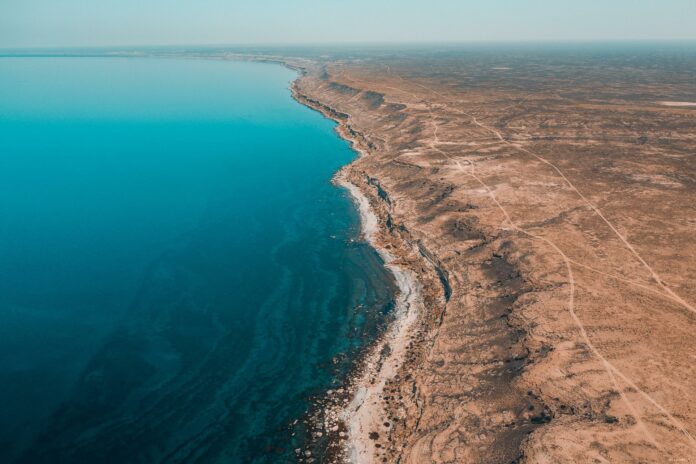The Caspian Sea, situated between Europe and Asia, is a body of water that can equally be classified as a lake or a sea. This is because it formed in a vast depression without any outlet to the ocean. Today, it is known as the Caspian Sea, but different peoples throughout history have given it numerous poetic names: Sihai, Bahr al-Khazar, and others. The ancient Greek storyteller Homer referred to it as the “pool of the sun.” There are about 70 known names for this body of water.
Interesting facts about the Caspian Sea:
- It is the largest enclosed body of water on Earth, meaning it has no outlets to the ocean. For this reason, oceanographers suggest classifying it as a saline endorheic lake, similar to the Dead Sea.
- Historians believe that the Caspian Sea got its name from the Caspians, ancient pastoral tribes, possibly of Scythian origin, who inhabited these lands over 3000 years ago.
- The surface area of the sea is 390,000 km2, with a coastline length of 7,000 km (including islands), and its maximum depth is 1,025 meters, making it the third deepest lake in the world.
- The Caspian Sea holds 44% of the world’s lake water reserves.
- Fishermen in the Caspian Sea catch unique albino belugas. The market price for the caviar of this fish can reach $2,000 per 100 grams.
- The water in the Caspian Sea completely replenishes every 200-250 years. In cold winters, the coast may freeze, but this happens infrequently, about once every 5-7 years.
- The highest wave ever recorded on the surface of the Caspian Sea reached a height of 11 meters.
- Despite its considerable size, there were no maps of the Caspian Sea until 1719. The area was meticulously explored and described by a group led by Bekovich-Cherkassky. It took them several years to process the collected data.
- The salinity level of the Caspian Sea waters is about 3-5% lower than in most other seas. Near the mouths of major rivers like the Volga and the Ural, the water is completely fresh. Approximately 130 rivers flow into the Caspian Sea.
- Mud volcanoes erupt on the southern coast, leading to the formation of new shoals and islets. Over time, they erode again, making the relief of this region dynamic.
Many prehistoric human settlements were located on the shores of the Caspian Sea. The ancient city of Derbent, founded in 438 AD, is located there. The sea was also formerly known as the Caspian Sea of Derbent. - According to modest estimates, there are oil reserves on the bottom of the brackish sea totaling at least 20 billion tons. Additionally, rich reserves of natural gas have been discovered here.
- There are 1,809 animal species and 728 plant species in the Caspian Sea, the vast majority of which are algae.
- According to residents of coastal regions, until recently, Caspian seals could often be seen swimming nearby. However, these animals are now rarely encountered.
- The territory of the Absheron Peninsula, part of the Caspian Sea basin, is heavily polluted due to oil extraction and processing. Despite this, a third of Azerbaijan’s population lives here, and numerous resorts are located in the area.
- Among divers, there are many legends about untold treasures hidden on the seabed of the Caspian Sea. However, so far, such stories remain unconfirmed.
- The Caspian Sea serves as a crucial habitat for several endangered species, including the Caspian seal, Caspian sturgeon, and Caspian tern. Conservation efforts are ongoing to protect these vulnerable species and their habitats.
- The Caspian Sea is rich in oil and gas resources, making it an important region for energy production. Several countries bordering the Caspian Sea, such as Kazakhstan, Turkmenistan, and Azerbaijan, have significant oil and gas reserves and are major producers in the global energy market.
- The Volga River, Europe’s longest river, flows into the Caspian Sea, contributing a significant amount of freshwater to the basin. This freshwater inflow helps maintain the Caspian Sea’s relatively low salinity levels in some areas.
- The Caspian Sea has experienced fluctuations in water level over time due to a combination of natural factors and human activities. Changes in precipitation, river flow, and evaporation rates can influence the sea’s water level, as can human interventions such as dam construction and water diversions.
- The Caspian Sea has been an important trade route for centuries, connecting Europe and Asia. Historically, it facilitated the exchange of goods, culture, and ideas between the civilizations along its shores.
- The Caspian Sea is home to several unique geological features, including mud volcanoes, underwater canyons, and ancient rock formations. These features provide valuable insights into the sea’s geological history and natural processes.
- The Caspian Sea’s coastline is diverse, ranging from sandy beaches to rocky cliffs and marshy wetlands. This variety of habitats supports a wide range of plant and animal life, including migratory birds, aquatic plants, and marine mammals.
- The Caspian Sea has long been a source of inspiration for artists, writers, and poets. Its vast expanse, changing colors, and dramatic landscapes have featured prominently in literature, music, and visual art throughout history.
- The Caspian Sea region has a rich cultural heritage, with diverse ethnic groups and languages spoken along its shores. The region’s cultural diversity is reflected in its architecture, cuisine, music, and traditions.
- The Caspian Sea has played a strategic role in geopolitics, with competing interests among the countries bordering the sea. Issues such as territorial disputes, resource extraction rights, and environmental conservation efforts have been the focus of diplomatic negotiations and international agreements.
